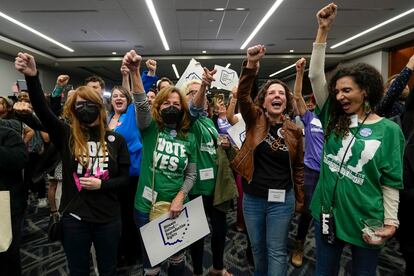The Republican state of Ohio votes to enshrine abortion rights
Voters have approved a constitutional amendment that protects women’s reproductive rights. It is the seventh vote to do so after ‘Roe vs Wade’ was overturned in 2022


Ohio voters enshrined abortion access in the Midwestern state at the ballot box on Tuesday. The state said yes to Issue 1: the question was whether they wanted to add an amendment to the state constitution guaranteeing the legality of terminating a pregnancy up to the point of fetal viability. Since the Supreme Court in June 2022 overturned Roe v. Wade (1973) — the landmark precedent that enshrined the federal right to abortion — there have been seven votes on constitutional amendments to enshrine abortion access in state constitutions. And on all seven occasions, voters have backed the measure.
The news, advanced by the U.S. media, is a huge blow to the anti-abortion movement in the United States, which for decades struggled to get the Supreme Court — the most conservative in eight decades — to overturn Roe v. Wade, even though, as the polls showed, two thirds of the U.S. population are in favor of reproductive rights.
Issue 1 was one of hundreds of ballot measures on Election Day, which comes every year on the first Tuesday after the first Monday of November. Voters in Ohio also approved a constitutional amendment to legalize recreational marijuana use for adults. The abortion question in Ohio was perhaps the most significant on a national level, but the issue also played a role in other races across the country.
In the Republican state of Kentucky, for example, Democrat Andy Beshear was re-elected after criticizing his Republican rival for his initial support of an anti-abortion law that allowed no exceptions for incest or rape. Meanwhile, in Virginia, Democrats swept the legislative elections after campaigning on abortion rights. If the Republicans, led by Governor Glenn Youngkin, had won control of the state House, they would have had a clear path to push through a law that banned abortion after 15 weeks.
Since Donald Trump burst onto the scene in 2016, Ohio has been considered a red state. The Republican Party campaigned fiercely against Issue 1, but did not sway voters. Ahead of the vote, the Republican governor, Mike DeWine, held a referendum that sought to ensure that constitutional amendments, such as Issue 1, could only be adopted with a qualified majority (60%) vote. It was designed precisely to make it more difficult for Issue 1 to prosper. But voters in Ohio voted against the measure.
Following the Supreme Court’s ruling, DeWine signed a law that banned abortion after cardiac activity can be detected, which occurs as early as six weeks. This amounted to a total ban on abortion, as most women do not know at that point that they are pregnant. The law was in effect for 82 days before judges overturned it and Ohio returned to its previous rule, which allows abortions up to the 23rd week. But in those 82 days, a 10-year-old girl who was raped made headlines when she was forced to travel to neighboring Indiana to get an abortion.
In the days leading up to Tuesday’s vote, pro-choice organizations criticized the “confusing” wording of the question, which was formulated by Republican officials. Many voters did not know what an affirmative or negative vote implied. The supporters of Issue 1, a group of citizens led by several physicians, wanted the amendment to stop the state from enacting any law that banned abortion before 23 weeks, but the text on the ballot, written by the Republican secretary of state of Ohio, Frank LaRose, falsely stated that the amendment would “always allow an unborn child to be aborted at any stage of pregnancy, regardless of viability.”
Ohio Attorney General Dave Yost, among other prominent Republicans who paid for costly television ads against Issue 1, stoked misinformation by arguing that the amendment would allow teens to have abortions without parental consent, an argument rejected by leading constitutionalists.
“These extreme anti-abortion politicians know they are out of step with Ohio voters and can’t win unless they lie, cheat, and rig the rules,” said Ohioans United for Reproductive Rights (OURR) spokesman Gabriel Mann.
Sign up for our weekly newsletter to get more English-language news coverage from EL PAÍS USA Edition
Tu suscripción se está usando en otro dispositivo
¿Quieres añadir otro usuario a tu suscripción?
Si continúas leyendo en este dispositivo, no se podrá leer en el otro.
FlechaTu suscripción se está usando en otro dispositivo y solo puedes acceder a EL PAÍS desde un dispositivo a la vez.
Si quieres compartir tu cuenta, cambia tu suscripción a la modalidad Premium, así podrás añadir otro usuario. Cada uno accederá con su propia cuenta de email, lo que os permitirá personalizar vuestra experiencia en EL PAÍS.
¿Tienes una suscripción de empresa? Accede aquí para contratar más cuentas.
En el caso de no saber quién está usando tu cuenta, te recomendamos cambiar tu contraseña aquí.
Si decides continuar compartiendo tu cuenta, este mensaje se mostrará en tu dispositivo y en el de la otra persona que está usando tu cuenta de forma indefinida, afectando a tu experiencia de lectura. Puedes consultar aquí los términos y condiciones de la suscripción digital.
More information
Archived In
Últimas noticias
New York enters the era of Zohran Mamdani
Welcome to the post-religion era: The idea of Christianity as the absolute truth has become obsolete
‘I thought you would like it’: The risky sexual practice popularized by TV shows and TikTok
The digitalization of tourism: ‘They promise experiences and gave us the worst possible one’
Most viewed
- Sinaloa Cartel war is taking its toll on Los Chapitos
- Reinhard Genzel, Nobel laureate in physics: ‘One-minute videos will never give you the truth’
- Oona Chaplin: ‘I told James Cameron that I was living in a treehouse and starting a permaculture project with a friend’
- Why the price of coffee has skyrocketed: from Brazilian plantations to specialty coffee houses
- Silver prices are going crazy: This is what’s fueling the rally










































